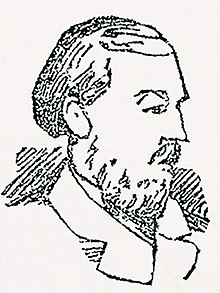William Henry Bury
William Henry Bury | |
|---|---|
 | |
| Status | Deceased |
| Other names | William Berry in error |
| Occupation | Sawdust merchant |
| Spouse | Ellen Bury (née Elliot) |
| Parent(s) | Henry and Mary Bury |
| Conviction(s) | Murder of Ellen Bury |
| Criminal charge | Murder of Ellen Bury |
| Penalty | Hanged |
William Henry Bury (25 May 1859 — 24 April 1889) was born in Stourbridge, Worcestershire and was executed in Dundee for the murder of his wife Ellen.
Childhood and youth
William lost both parents in infancy. His father, Henry, died in a horse and cart accident when William was only three months old in August 1859. His mother Mary Bury (nee Hendy), was committed to Worcester County & City lunatic asylum, suffering from melancholia, in May 1860. She remained there until her death aged 33 on 30th March 1864.
William was the youngest of three, having one brother and a sister who had both died by the time William moved to London. He was raised and provided with a solid education by a close family friend and attended the Blue Coat Orphanage in Stourbridge.
At the age of sixteen, he found work as a factors clerk in a warehouse at Horsley Fields, Wolverhampton. He then worked for Osbourne, a lock manufacturer in Lord Street, Wolverhampton until 1884/5. His whereabouts for the next few years are not known. However, during the summer of 1887 he was back in the Midlands making a living as a hawker, selling items such as lead pencils and toy rings on the streets in Snow Hill, Birmingham.
London
He was 28 years old when he arrived in Bow, London in October 1887 and found work as a sawdust hawker to James Martin who also ran what has been described as a brothel at 80 Quickett Street. Bury moved in with Martin and it was here he met Ellen Elliot (32), a barmaid, prostitute and the daughter of a publican. They married in April 1888.
Various acquaintances described Bury as a violent drunk, and on one occasion, his landlady at 3 Swaton Road, caught Bury kneeling on his bride of 5 days attempting to cut her neck with a knife. He was subsequently thrown out of this address for “violence and bad language”. In December 1888, he told his landlord at 3 Spanby Road that he was thinking of emigrating to Brisbane, Australia and asked him to make 2 wooden crates for the journey. William and Ellen Bury moved to Dundee in Scotland instead.
Dundee
The Burys travelled as 2nd class passengers on the steamer Cambria on their trip north. On the morning of 21st January 1889, they arrived at 43 Union Street, Dundee. The Burys stayed for only eight days; then on the 29th January 1889, they moved to 113 Princes Street, a basement flat under a shop.
On 8th February 1889, Bury spent the whole day in court, taking notes and listening attentively. On 10th February, he walked into the Dundee Central Police Station and reported his wife’s suicide to Lieutenant James Parr. He said they had been drinking heavily the night before her death, and he had woken in the morning to find his wife’s body on the floor, with the rope around her neck. Bury did not attempt to summon a doctor, but, after looking at the body, was seized with rage and thrust a knife several times into Ellen’s abdomen. Sometime after this, Bury was afraid that he would be arrested as Jack the Ripper. In his panic, he concealed the body in a large box.
Bury was taken upstairs to see Lt. David Lamb. Parr told Lamb, “Bury had a wonderful story to tell”. Parr remained to hear the re-telling of Bury’s story, but the ‘Jack the Ripper’ reference was omitted. He also said that he stabbed his wife’s body only once. At Bury’s dingy flat was discovered the mutilated remains of Ellen stuffed into the wooden box Bury had commissioned in London, and chalk graffiti saying "jack ripper is at the back of this door" and "jack ripper is in this seller"(sic) on a door.
Detectives from London travelled north to quiz Bury about his movements in London, but after an interview didn’t consider him a realistic suspect. Bury was tried for the murder of his wife in a hearing lasting 13 hours and found guilty. He was hanged on 24th April 1889.
Why Bury is a Jack the Ripper suspect
Marjorie Smith who ran the shop above Bury’s Princes Street flat in Dundee asked “What sort of work you Whitechapel folk have been about, letting Jack the Ripper kill so many people”? Bury went silent, but Ellen said “Jack the Ripper is quiet now”. She later told another neighbour, “Jack the Ripper is taking a rest”. Did Ellen know something is the question people have asked since?
Mrs Smith also lent Bury a chopper and asked him, “Surely you are not Jack the Ripper?” Bury replied, “I do not know so much about that.”
Bury’s alleged comments to Lt. Parr in the Dundee police station where he said he was “Jack the Ripper” or “a Jack the Ripper”.
David Walker, a brief acquaintance in Dundee, said that Bury threw down a newspaper he was reading when asked if there was “anything about Jack the Ripper” in it.
The Jack the Ripper graffiti at his Dundee flat.
Bury’s time in Bow, near Whitechapel, during the period October 1887 to January 1889, places him fairly near the Whitechapel murders at the appropriate time.
He murdered his wife in a manner not dissimilar to the murders of Mary Ann Nichols and Martha Tabram according to some observers.
References
Casebook: Jack the Ripper [1]
William Beadle, “Jack the Ripper: Anatomy of a Myth “
Euan MacPherson, “The Trial of Jack the Ripper”
